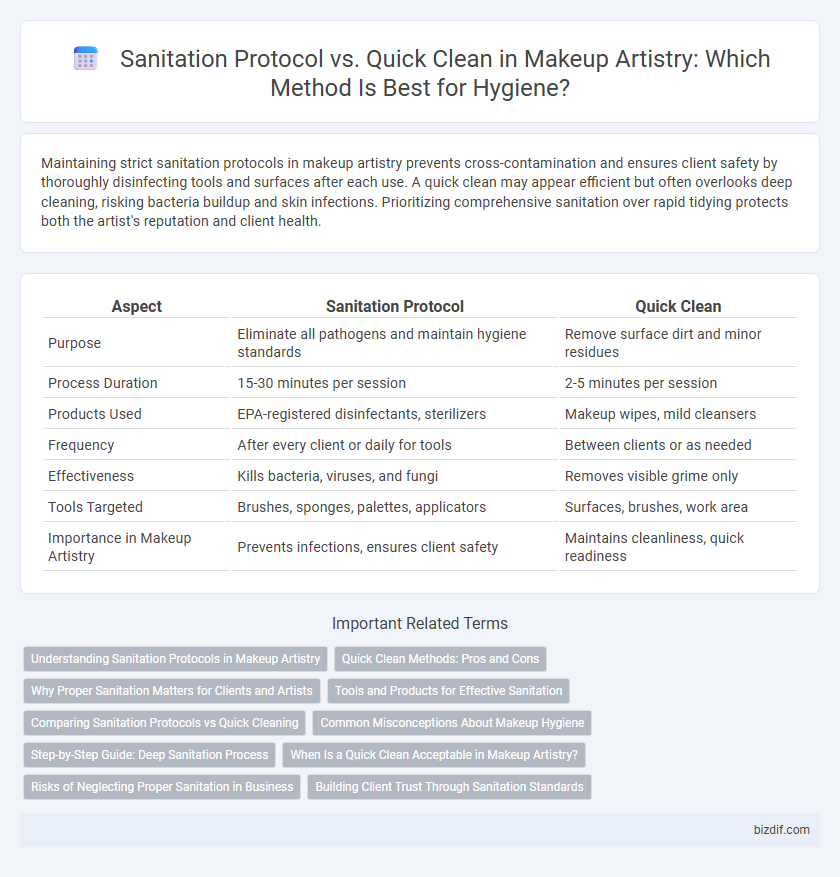Maintaining strict sanitation protocols in makeup artistry prevents cross-contamination and ensures client safety by thoroughly disinfecting tools and surfaces after each use. A quick clean may appear efficient but often overlooks deep cleaning, risking bacteria buildup and skin infections. Prioritizing comprehensive sanitation over rapid tidying protects both the artist's reputation and client health.
Table of Comparison
| Aspect | Sanitation Protocol | Quick Clean |
|---|---|---|
| Purpose | Eliminate all pathogens and maintain hygiene standards | Remove surface dirt and minor residues |
| Process Duration | 15-30 minutes per session | 2-5 minutes per session |
| Products Used | EPA-registered disinfectants, sterilizers | Makeup wipes, mild cleansers |
| Frequency | After every client or daily for tools | Between clients or as needed |
| Effectiveness | Kills bacteria, viruses, and fungi | Removes visible grime only |
| Tools Targeted | Brushes, sponges, palettes, applicators | Surfaces, brushes, work area |
| Importance in Makeup Artistry | Prevents infections, ensures client safety | Maintains cleanliness, quick readiness |
Understanding Sanitation Protocols in Makeup Artistry
Sanitation protocols in makeup artistry ensure the prevention of cross-contamination by adhering to strict guidelines such as using disposable applicators, sterilizing tools with FDA-approved disinfectants, and maintaining clean workstations. Quick clean methods focus on surface-level tidiness but often lack comprehensive microbial control, increasing the risk of skin infections and allergic reactions. Understanding and implementing full sanitation protocols is essential for makeup artists to protect client health and maintain professional standards.
Quick Clean Methods: Pros and Cons
Quick clean methods in makeup artistry offer rapid sanitization by using alcohol wipes and surface sprays to reduce microbial contamination between clients, optimizing time efficiency for busy professionals. These methods effectively maintain hygiene but may not eliminate all pathogens, increasing the risk of cross-contamination compared to thorough sanitation protocols involving sterilization tools like UV cabinets or autoclaves. Makeup artists must weigh the convenience of quick cleans against the comprehensive protection provided by standard sanitation procedures to ensure client safety and regulatory compliance.
Why Proper Sanitation Matters for Clients and Artists
Proper sanitation in makeup artistry prevents cross-contamination and reduces the risk of infections, protecting both clients and artists from harmful bacteria and viruses. Thorough sanitation protocols ensure all tools and surfaces are disinfected, maintaining a hygienic environment that supports skin health and client confidence. Quick clean methods may save time but often compromise safety, making rigorous sanitation essential for professional and ethical makeup application.
Tools and Products for Effective Sanitation
Proper sanitation protocols in makeup artistry require using EPA-registered disinfectants and sterilizing tools with UV or autoclave methods to eliminate harmful pathogens. Quick clean techniques involve wiping brushes and sponges with alcohol-based solutions or antimicrobial sprays between uses to reduce contamination risk. Consistently maintaining clean makeup tools and products ensures skin safety and prevents cross-contamination during makeup application.
Comparing Sanitation Protocols vs Quick Cleaning
Sanitation protocols in makeup artistry involve comprehensive disinfection processes targeting all tools and surfaces to prevent cross-contamination and ensure client safety. Quick cleaning typically refers to superficial wiping or brush cleaning between clients, which may reduce some contaminants but does not eliminate pathogens effectively. Comparing sanitation protocols to quick cleaning highlights that thorough sanitation is essential for maintaining hygiene standards, whereas quick cleaning is a temporary measure insufficient for infection control.
Common Misconceptions About Makeup Hygiene
Many makeup artists confuse quick cleaning with thorough sanitation, leading to unsafe hygiene practices. Proper sanitation protocols involve disinfecting tools with approved solutions to eliminate bacteria and fungi, whereas quick cleans only remove surface dirt. Understanding this distinction is crucial to prevent skin infections and ensure client safety in professional makeup artistry.
Step-by-Step Guide: Deep Sanitation Process
A step-by-step deep sanitation process in makeup artistry begins with thoroughly disinfecting all tools using EPA-registered sanitizer followed by washing brushes with antimicrobial soap and warm water. Next, surfaces such as workstations and palettes are wiped with hospital-grade disinfectants to eliminate bacteria and viruses. This rigorous sanitation protocol contrasts with a quick clean by ensuring comprehensive hygiene that prevents cross-contamination and maintains client safety.
When Is a Quick Clean Acceptable in Makeup Artistry?
Quick clean procedures in makeup artistry are acceptable when transitioning between clients using the same set of tools within a short time frame, provided that surface sanitation and brush cleaning protocols are rigorously followed to minimize contamination risks. Sanitation protocols involve thorough disinfection of all tools, brushes, and products after each client, ensuring the elimination of bacteria, viruses, and fungi to maintain client safety and professional standards. Rapid cleaning methods are suitable only for non-porous tools and surfaces that come into direct contact with skin, while full sanitation is mandatory for any potentially contaminated items to prevent cross-contamination and infections.
Risks of Neglecting Proper Sanitation in Business
Neglecting proper sanitation protocols in makeup artistry can lead to severe risks such as cross-contamination, skin infections, and potential transmission of bloodborne pathogens. Quick cleans often fail to eliminate harmful bacteria and viruses, increasing client exposure to infectious agents and compromising overall hygiene standards. Consistent adherence to comprehensive sanitation practices is crucial for maintaining a safe environment, protecting both clients and professionals from health hazards.
Building Client Trust Through Sanitation Standards
Strict sanitation protocols in makeup artistry involve thorough disinfecting of brushes, tools, and workspaces between clients, significantly reducing the risk of cross-contamination and skin infections. Quick clean methods may save time but often overlook deeper sterilization, potentially compromising client safety and confidence. Consistently adhering to comprehensive sanitation standards builds client trust by demonstrating professionalism and commitment to their health.
Sanitation protocol vs Quick clean Infographic

 bizdif.com
bizdif.com